This post may contain affiliate links. Please read my disclosure and privacy policy.
If you enjoy baking with almond flour as much as I do, you might find yourself in a situation where you want or need to make it at home. It could save you an extra trip to the grocery store or help you use up some extra almonds in your pantry!
Making homemade almond flour is easy, but I’ve recently learned a new trick for making it more like the finely ground store-bought variety. (Hint: It involves the fine mesh strainer I use almost every day, anyway.)
I’ll also show you how to use almond flour as a swap for all-purpose flour, and a few trusted recipes to help you get started.
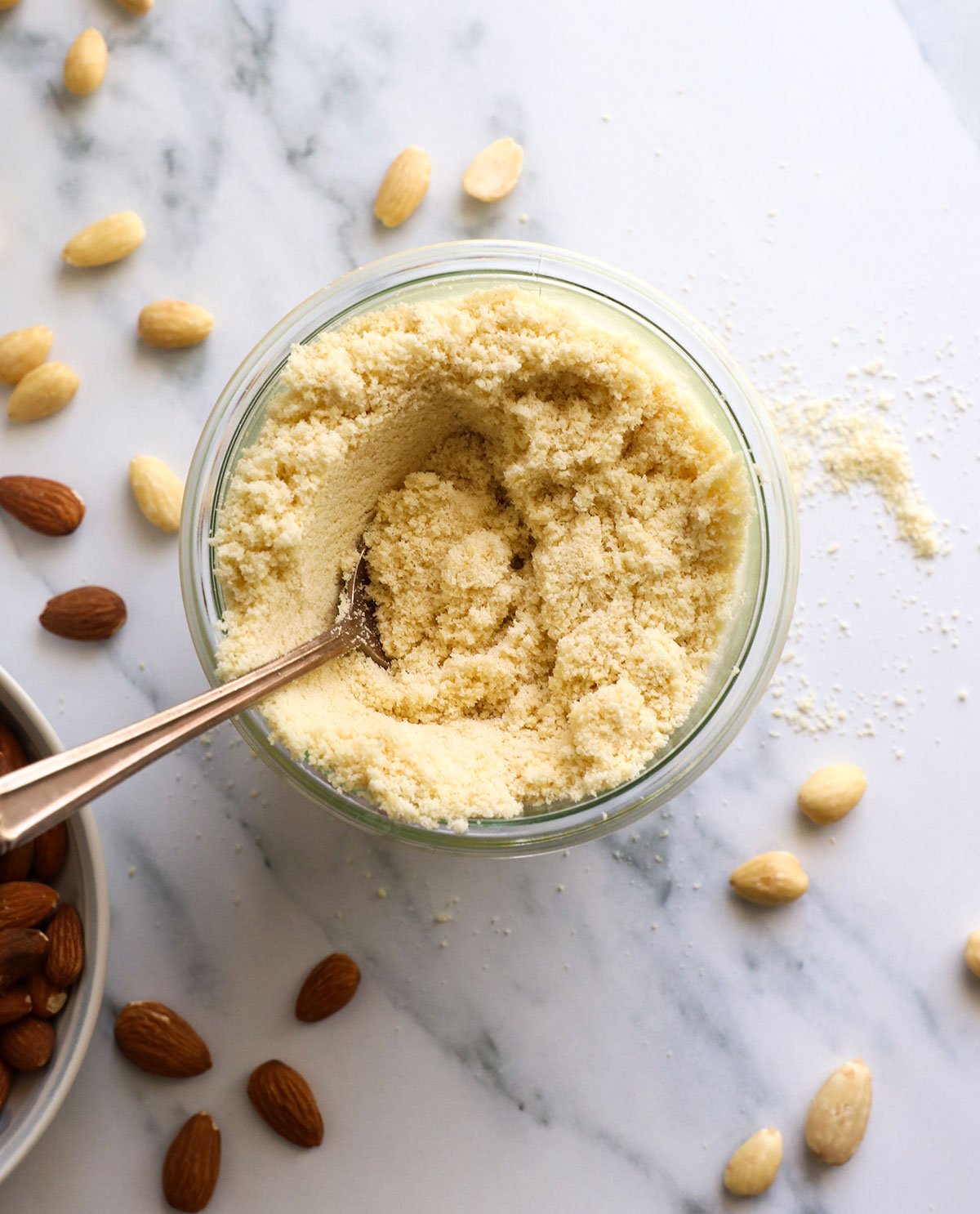
Ingredients for Almond Flour
The only ingredient in almond flour is, not surprisingly, almonds. When you buy almond flour at the store, it’s likely made with blanched almonds, which means their skins have been removed first.
Using blanched almonds will yield a finely ground flour that produces fluffier cakes and muffins, as well as cookies with a more buttery texture. Blanched almond flour, in general, will give you the best results in baking.
If you want to grind whole almonds, you’ll be making almond meal instead.

How to Make Almond Flour
Step 1:
In a food processor or high-speed blender, add 8 ounces of almonds. This is about 1 1/2 cups of whole almonds if you don’t own a food scale, and will produce about 2 cups of almond flour when you’re done processing it. (Because it gets fluffier.)
Secure the lid and process for about 30 seconds. Stop and scrape down the sides of the machine, then pulse the almonds again.
After about 60 seconds, the almonds should appear finely ground.

Step 2:
No matter which machine you use, you’ll likely have a few almond pieces that were missed. You can filter these out by pouring the flour through a fine mesh strainer arranged over a large bowl.
Shake the strainer, like you’re sifting the flour, until only larger chunks of almonds are left in the strainer. In the bowl below, you should have finely ground almond flour, ready to use in recipes.
You can return the larger almond pieces to the machine and attempt to process them again, or just save them separately to add to a recipe when you want a little added texture. (Such as salads, quick breads, or granola.)

Almond Meal vs. Almond Flour
If a recipe calls for almond flour, it’s likely assuming that you’re using blanched almond flour, meaning the skins were removed from the almonds before they were ground finely.
Almond meal is another popular option made from whole almonds that have been finely ground. You can make this at home using the same method described above.
The main difference is that it’s not as easy to strain this variation. (Most of the almond meal would not fall through my fine mesh strainer, so I couldn’t make it as “fine” in texture as the blanched almond flour.
When using almond meal instead of almond flour, you might find that baked goods turn out more dense, rather than buttery, fluffy, or crisp around the edges.

How to Substitute Almond Flour for Regular Flour
Unfortunately, almond flour is not a 1:1 swap for all-purpose flour. This is likely because it contains more fat than grain-based flours.
I experimented with chocolate chip cookies and found that I needed to nearly double the flour a recipe called for when using almond flour. So, it might be a safer bet to 2x the flour when using almond flour instead of all-purpose flour.
With that being said, it’s a better idea to look for a recipe that’s already been tested with almond flour. That way, there’s no guesswork for you!

Almond Flour Recipes to Try
Try one of these popular options to get started:
- Chocolate Chip Cookies
- Almond Flour Brownies
- Fluffy Almond Flour Cake
- Chocolate Almond Flour Cupcakes
- Almond Flour Pancakes

Ingredients
- 8 ounces blanched almonds , whole or slivered
Instructions
- Place the blanched almonds in a high-speed blender or food processor, and process until they are finely ground. If using a high-speed blender, be sure not to over-process as the almonds will eventually start to release their oils and become almond butter.
- For best results, do not blend more than 8 ounces of almonds at a time. (I tried using 16 ounces and couldn’t get them evenly ground.) For the most finely-ground results, I’ve found a blender works best, but the flour I made in the food processor also works for making almond flour recipes– the final product is just slightly grainier.
- For fine almond flour, pour the processed almonds into a fine mesh strainer arranged over a large bowl. Shake the strainer to sift the flour through the mesh. This will catch any large pieces the processing might have missed, leaving you with finely ground flour in the bowl. This flour is ready to use right away in your favorite almond flour recipes.
Notes
Nutrition
How Long Does Almond Flour Last?
You can store almond flour in the pantry for 3 to 6 months, as long as it remains moisture-free. (Meaning your food processor wasn’t wet when you processed this, and you didn’t blanch the almonds and then immediately process them while wet.)
Almond flour can last up to 12 months when stored in an airtight container in the fridge or freezer. You can usually smell when it starts to go rancid, so check on it before using it in a recipe. If it smells sour or bitter, like old cooking oil, it’s time to make a fresh batch.
If you try this almond flour recipe, please leave a comment and star rating below to let me know how you like it.



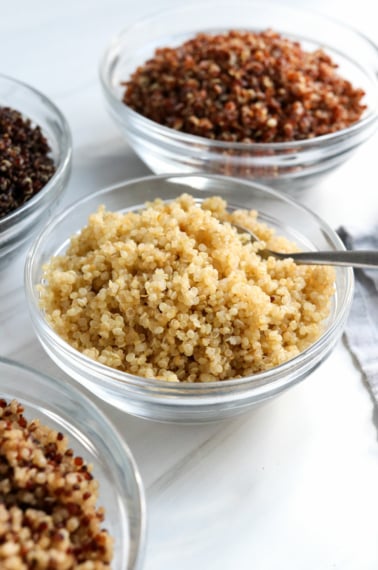
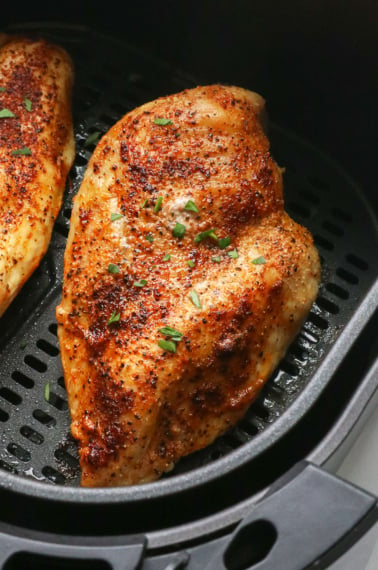
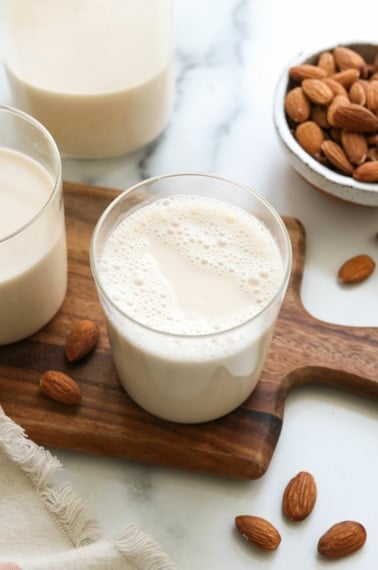
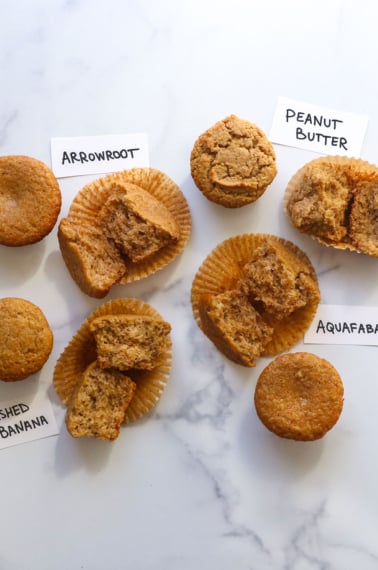






Why BLANCHED?
The most common type of almond flour that recipes call for is blanched almond flour. Removing the almond skins gives the almond flour a more fine texture for a fluffy baked good. If you want to use almonds with the skin on, I’d use it in recipes that call for almond meal instead, or expect the result to be slightly more dense.
Hi. I am wondering if you could update your info with buying a large raw almond canister of almonds from Costco and how to blanch them.
I recently had to return a bag of Keto flour made with MCT oil because it turned out to be $18!!!
Do you have a recipe for making your own keto flour? Also if I want to make a loaf of bread that requires at least 3.5 cups of regular flour. Can organic flour be mixed half and half for a low carb alternative?
Oh thanks so much for your experience. I found this very helpful and love your tips, that were also helpfu. Making Macarons
This would be great dusted on top of a frosted cake, or ice cream, brownies, etc. However given the price of almonds, I think that using this as a substitute for flour in say a loaf of bread would be extremely expensive.
Now consider.. gluten free vs HUGE amount of calories and FAT.. Don’t sacrifice the healthy choice for a trendy “fad” Humans have been eating gluten for millennia.
I tried to make almond flour but it seemed to be getting sticky. Also there were pieces that didn’t grind. I was using a blender. Maybe I should try my processor?
I just blanched some almond to remove the skin. Do I have to dry it out first before putting in blender. Thank you?
Yes, I think they would need to be totally dry before grinding them into flour.
hi!!! I was just wondering if I can use this almond flour recipe to make macarons?
Life saver
Would a spice grinder be good to use instead of a blender?
Yes, I think that would work fine, too!